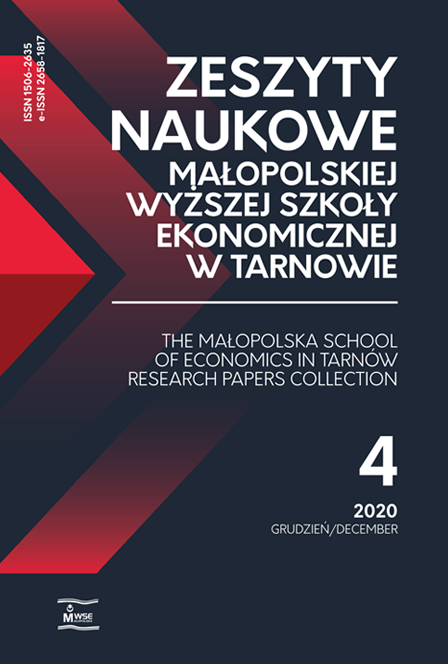Abstract
Over the years industrial robots had been used for numerous of repeatable tasks in different fields of industry, especially in automotive. Due to the safety reasons, robotized working stations had to be isolated by safety cell. Nowadays we can observe a strong trend of automation and robotization of production processes, which is considered as the fourth industrial revolution. Industry 4.0 has brought new opportunities and challenges. One of the key directions of Industry 4.0 is Human-Robot Collaboration (HRC). According to this concept, collaborative robot, which is equipped with appropriate safety and collision avoidance systems, can assist the human in the most effortable and monotonic tasks in the same workspace without additional safety guard. In this paper the characteristic of Human-Robot Collaboration (HRC), safety regulations, as well as application examples of collaborative robots are presented.
References
ABB. (2018). ABB Group official website [online, accessed: 2018-03-12]. Retrieved from: http://www.new.abb.com.
View in Google Scholar
Bauer, W. (ed.), Bender, M., Braun, M., Rally, P., Scholtz, O. (2016). Lightweight robots in manual assesmbly – best to start simply!. Stuttgart: Fraunhofer Institute for Industrial Engineering IAO.
View in Google Scholar
DPCCars. (2017). BMW Factory humans and robots work togeter at Dingolfing Plant [online, accessed: 2018-03-12]. Retrieved from: http://www.youtube.com/watch?v=Dm3Nyb2lCvs.
View in Google Scholar
FANUC. (2017). Promotion materials [online, accessed: 2018-03-12]. Retrieved from: www.youtube.com/watch?v=tlgKsTMmywk.
View in Google Scholar
FANUC. (2018). FANUC official website [online, accessed: 2018-03-12]. Retrieved from: www.fanuc.eu.
View in Google Scholar
Fast-Berglund, Å., Palmkvist, F., Nyqvist, P., Ekered, S., Åkerman, M. (2016). Evaluating cobots for final assembly. Procedia CIRP, 44, 175–180. DOI: 10.1016/j.procir.2016.02.114.
View in Google Scholar
Gopinath, V., Oreb, F., Johansen, K. (2017). Safe Assembly Cell Layout through risk assessment—an application with hand guided industrial robot. Procedia CIRP, 63, 430–435. DOI: 10.1016/j.procir.2017.03.160.
View in Google Scholar
Grahn, S., Langbeck, B., Johansen, K., Backman, B. (2016). Potential advantages using large anthropomorphic robots in human-robot collaborative, hand guided assembly. Procedia CIRP, 44: 281–286. DOI: 10.1016/j.procir.2016.02.036.
View in Google Scholar
Hull, T., Minarcin, M. A. (2016). Considerations in collaborative robot system designs and safeguarding. SAE International, 9(3), 545–551.
View in Google Scholar
ISO. (2016). ISO/TS 15066:2016: Robots and robotic devices—Collaborative robots. Geneva: International Organization for Standardization.
View in Google Scholar
Kujawińska, A., Vogt, K., Diering, M., Rogalewicz, M., Waigaonkar, S. D. (2018). Organization of visual inspection and its impact on the effectiveness of inspection. In: A. Hamrol, O. Ciszak, S. Legutko, M. Jurczyk (eds.). Advances in manufacturing: Lecture notes in mechanical engineering (pp. 899–909). Cham: Springer Ingternational Publishing. ISBN 9783319686196. DOI: 10.1007/978-3-319-68619-6_87
View in Google Scholar
KUKA. (2017). Promotion materials [online, accessed: 2018-03-12]. Retrieved from: www.youtube.com/watch?v=OxNC8yvsZ6s.
View in Google Scholar
KUKA. (2018a). First HRC system at BMW Group’s Dingolfing Plant [online, accessed: 2018-03-12]. Retrieved from: http://www.kuka.com/en-us/industries/solutions-database/2017/06/solution-systems-bmw-dingolfing.
View in Google Scholar
KUKA. (2018b). KUKA official website [online, accessed: 2018-03-12]. Retrieved from: www.kuka.com.
View in Google Scholar
Müller, R., Vette, M., Mailahn, O. (2016). Process-oriented task assignment for assembly processes with human-robot interaction. Procedia CIRP, 44, 210–215. DOI: 10.1016/j.procir.2016.02.080.
View in Google Scholar
Müller, R., Vette, M., Scholer, M. (2014). Inspector Robot—a new collaborative testing system designed for the automotive final assembly line. Procedia CIRP, 23, 59–64. DOI: 10.1016/j.procir.2014.10.093.
View in Google Scholar
Patalas-Maliszewska, J., Kłos, S. (2018). An intelligent system for core-competence identification for Industry 4.0 based on research results from German and Polish manufacturing companies. In: A. Burduk, D. Mazurkiewicz (eds.). Intelligent systems in production engineering and maintenance – ISPEM 2017 (pp. 131–139). Cham: Springer International Publishing. ISBN 9783319644646. DOI: 10.1007/978-3-319-64465-3_13.
View in Google Scholar
Ranza, F., Hummela, V., Sihnb W. (2017). Capability-based task allocation in human-robot collaboration. Procedia Manufacturing, 9, 182–189. DOI: 10.1016/j.promfg.2017.04.011.
View in Google Scholar
Schröter, D., Jaschewski, D., Kuhrke, B., Verl, A. (2016). Methodology to identify applications for collaborative robots in powertrain assembly. Procedia CIRP, 55, 12–17. DOI: 10.1016/j.procir.2016.08.015.
View in Google Scholar
TUV Austria. (2017). Safety in Human-Robot Collaboration [online; accessed: 2018-03-12]. Vienna: TÜV Austria Holding AG, Fraunhofer Austria Research, Joanneum Research. Retrieved from: www.tuvat.asia.
View in Google Scholar
UR. (2009–2015). User manual UR 10/CB3: Version 31: Original Instructions [online, accessed: 2018-03-12]. Universal Robots. Retrieved from: http://fab.cba.mit.edu/content/tools/universal_robot_arms/ur10_user_manual_en_global.pdf.
View in Google Scholar
UR. (2018). Universal Robots official website [online, accessed: 2018-03-12]. Retrieved from: www.universal-robots.com.
View in Google Scholar
Varela, M. R. L., Trojanowska, J., Carmo-Silva, S., Costa, N. M. L., Machado J. (2017). Comparative simulation study of production scheduling in the hybrid and the parallel flow. Management and Production Engineering Review, 8(2), 69–80. DOI:10.1515/mper-2017-0019.
View in Google Scholar

This work is licensed under a Creative Commons Attribution-NonCommercial-NoDerivatives 4.0 International License.

